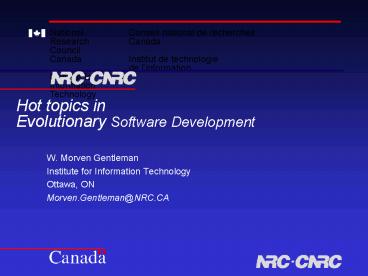Hot topics in Evolutionary Software Development - PowerPoint PPT Presentation
1 / 20
Title:
Hot topics in Evolutionary Software Development
Description:
Evolutionary software development recognizes that planning for the whole ... How to reuse walkthroughs? How to reuse reviews? How to beta-test successive releases? ... – PowerPoint PPT presentation
Number of Views:22
Avg rating:3.0/5.0
Title: Hot topics in Evolutionary Software Development
1
Hot topics in Evolutionary Software Development
National Research Council Canada Institute
for Information Technology
Conseil national de recherches Canada Institut
de technologie de linformation
- W. Morven Gentleman
- Institute for Information Technology
- Ottawa, ON
- Morven.Gentleman_at_NRC.CA
2
What is Evolutionary Software Development?
- Successful software must evolve
- To address new requirements
- To take advantage of new technology
- To meet new expectations.
- Conventionally each update is treated as an
isolated project with fixed specifications
3
What is Evolutionary Software Development?
- Evolutionary software development recognizes that
planning for the whole lifetime, with all its
changes, can reduce life cycle costs and
accelerate delivery of new functionality
4
1. Choices for Process Software Architecture
- What architectures preserve investment?
- What architectures facilitate evolution?
- What architectures inhibit evolution?
- What processes avoid redundancy?
- What processes facilitate evolution?
- What processes inhibit evolution?
- How would you substantiate these claims?
5
2. Incremental Delivery
- Is the time scale nightly build?
- Is the time scale product release?
- How do you decide what to defer?
- How does deferred functionality appear?
- What provision is made for upgrades?
6
3. Concurrent Development of Successive Releases
- When to initiate development on new release?
- Same team or different teams?
- How to (retro)fit changes to multiple releases?
- How to represent ideas for future releases?
7
4. Coping with Platform Evolution
- Both hardware and software platforms?
- Anticipated and unexpected evolution?
- Exploit generated code and other indirection?
- Other tools?
8
5. Coping withProcess Change
- Change to mandated process for use?
- If process changes, how must history change?
- Can history with old process aid new process?
9
6. Data Structure Format Evolution
- Changes in
- Input?
- Output?
- Database?
- Control actions?
- Conversion tools?
10
7. Interoperability
- Interoperability supported at all levels
- coexistence with other software?
- backward and forward compatibility?
- explicit complementary competitive products?
- Recognize that software used in conjunction with
this software evolves too?
11
8. Scaffolding
- (Ancillary software used to build products)
- What scaffolding is unique to a specific release?
- What scaffolding need be reused for each release?
- Implications for building scaffolding?
12
9. Configuration Management
- Developers geographically distributed?
- Developers organizationally distributed?
- Product families?
- Nontextual entities?
- Configuration management at customer sites?
13
10. Automated Upgrading
- Improve registry concept and implementation?
- Better configuration probing?
- Identifying and updating saved data?
- Verification of successful installation?
- Uninstall and other failure handling?
- Generating feedback to developers?
14
11. Testing
- What regression testing is appropriate?
- Can integration testing be simplified?
- What inter-release consistency testing is needed?
- How to do installation testing?
- Changes induce how much integrity testing?
15
12. Incremental Quality Assurance
- How to reuse walkthroughs?
- How to reuse reviews?
- How to beta-test successive releases?
- How to achieve incrementality?
16
13. Field Support for Several Releases
Simultaneously
- Detection of which release automatic?
- Automatically identify relevant data and snapshot
it? - Choice of updates automatically?
- Adequate recording in registry?
17
14. Aids for Retraining Users
- Semi-automation for design and production of
training tutorials? - Semi-automation for design and production of
interactive exercises? - Semi-automation for design and production of
integrated wizards?
18
15. Project Metric Tracking
- Product metrics
- What metrics are required?
- How to collect data?
- How to interpret results?
- Process metrics
- What metrics are required?
- How to collect data?
- How to interpret results?
19
16. Implications for Procurement
- Balancing long-term relationships
- Cost of maintaining team?
- Challenge of sustaining interest?
- Commitment to continued activity?
- Opportunities for reassessment?
- Support for long-term Prime/Sub relationships?
- Alternatives for progress payments?
- How to change the culture Change to what?
20
Conclusions
- Plentiful opportunities for research
- Gaining acceptance is the principal challenge
- Technical problems must be solved, but ultimate
issues are not technical





























![NOTE: To appreciate this presentation [and insure that it is not a mess], you need Microsoft fonts: PowerPoint PPT Presentation](https://s3.amazonaws.com/images.powershow.com/6332463.th0.jpg?_=20200910128)

